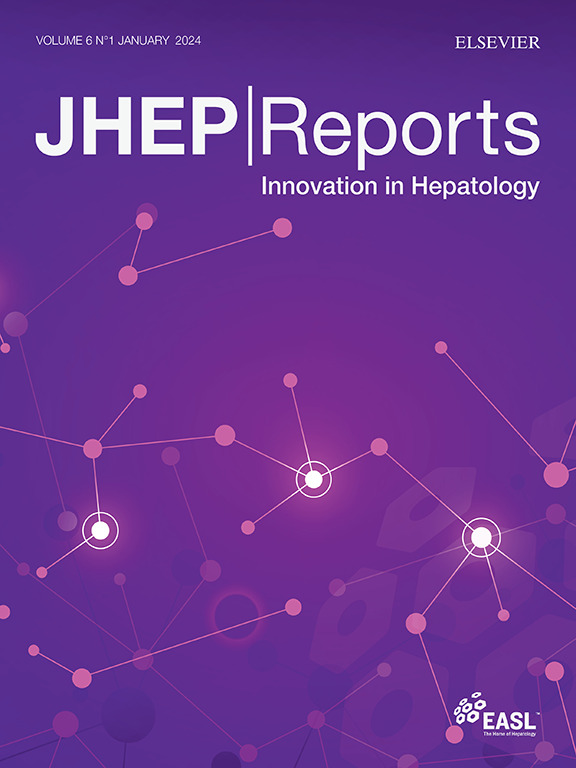成熟肝细胞的单细胞分析揭示了irf1驱动的HDV感染限制
IF 7.5
1区 医学
Q1 GASTROENTEROLOGY & HEPATOLOGY
引用次数: 0
摘要
背景,目的干细胞衍生的肝细胞样细胞(hlc)是肝细胞再生成熟肝功能的体外模型。然而,异质性或不完善的分化可能会限制它们的生物学相关性。hlc易感染所有原发性肝炎病毒,包括HDV。重要的是,hcc支持有限的HDV复制,其水平明显低于肝癌细胞系。方法采用单细胞RNA测序(scRNAseq)技术对对照组和hdv感染的hlc进行分析。我们评估了HLCs人群的成熟度和异质性。我们在单细胞水平上可视化了病毒基因组和抗基因组序列的丰度和先天免疫反应。在hcc和肝癌细胞系中进行了进一步的功能表征。结果shlc形成的肝细胞群表现出不同程度的成熟,与肌成纤维细胞/肝细胞的少量杂交群体相关的不成熟表型。在HDV接种后,干扰素刺激基因在感染细胞中被诱导表达,但在旁观者的hlc中没有。此外,干扰素调节因子1 (IRF1)在感染的病毒基因组复制水平检测不到的HLCs中富集,表明它可能限制病毒感染。将hlc中IRF1的表达降低50%,可将HDV感染的易感性提高10倍(p <0.01)。此外,肝癌细胞系中IRF1的过表达恢复了IRF1效应抗病毒基因的生理基础水平,并抑制了HDV感染(7天后降低了50%,p <0.01)。重要的是,在表达IRF1的细胞中,培养2周后细胞分裂介导的传播被抑制,感染显著减少(>;1.5 log下降,p <0.001)。结论:hlc的scrnaseq通过抗病毒机制在病毒周期的早期阻断HDV感染,确定IRF1是HDV感染的有效限制因子。影响和意义我们对对照和hdv接种的干细胞来源的肝细胞进行了单细胞RNA测序,并在肝脏分化、病毒丰度和对感染的反应方面对它们进行了表征。我们发现IRF1是限制成熟肝细胞中HDV感染的组成细胞因子,特别是针对细胞质中的HDV。这项工作提高了我们对HDV成熟细胞培养模型的理解,需要破译其宿主-病原体相互作用。抗病毒效应基因的鉴定为开发新的宿主靶向抗病毒策略开辟了道路,特别是针对目前使用的进入抑制剂(Hepcludex)无法抑制的细胞分裂介导的传播。本文章由计算机程序翻译,如有差异,请以英文原文为准。

Single-cell analysis of mature hepatocytes reveals an IRF1-driven restriction of HDV infection
Background & Aims
Stem cell-derived hepatocyte-like cells (HLCs) are an in vitro model of hepatocytes reproducing mature hepatic functions. However, heterogeneous or imperfect differentiation may limit their biological relevance. HLCs are susceptible to all primary hepatitis viruses, including HDV. Importantly, HLCs support limited HDV replication, at a significantly lower level than hepatoma cell lines.
Methods
We used single-cell RNA sequencing (scRNAseq) to analyse control and HDV-infected HLCs. We assessed maturation and heterogeneity of the HLCs population. We visualised viral genomic and antigenomic sequences abundance and innate immune response at the single-cell level. Further functional characterisation was performed in HLCs and hepatoma cell lines.
Results
HLCs form a population of hepatocytes exhibiting various levels of maturation, with a minor hybrid population of myofibroblast/hepatocyte cells associated with immature phenotype. Upon HDV inoculation, Interferon-Stimulated Genes expression was induced in infected cells, but not in bystander HLCs. Moreover, Interferon Regulatory Factor 1 (IRF1) was enriched in infected HLCs with undetectable levels of viral genome replication, suggesting it may restrict viral infection. Decreasing IRF1 expression in HLCs by 50% improved susceptibility to HDV infection by 10-fold (p <0.01). Moreover, IRF1 overexpression in hepatoma cell lines restored physiological basal level of IRF1 effector antiviral genes and inhibited HDV infection (∼50% reduction after 7 days, p <0.01). Importantly, in IRF1 expressing cells, cell division-mediated spread was inhibited and infection was significantly decreased after 2 weeks of culture (>1.5 log decrease, p <0.001).
Conclusions
scRNAseq of HLCs identified IRF1 as a potent restriction factor of HDV infection, through an antiviral mechanism blocking HDV infection at an early step of the viral cycle.
Impact and implications
We performed single-cell RNA sequencing of control and HDV-inoculated stem cell-derived hepatocytes, and characterised them in terms of hepatic differentiation, viral abundance and response to infection. We identified IRF1 as a constitutive cellular factor restricting HDV infection in mature hepatocytes, particularly targeting HDV in the cytoplasm. This work improves our understanding of mature cell culture models for HDV, needed to decipher its host–pathogens interactions. Identification of antiviral effector genes opens the way to the development of new host targeted antiviral strategies, particularly for targeting cell division-mediated spread that is not inhibited by currently used entry inhibitors (Hepcludex).
求助全文
通过发布文献求助,成功后即可免费获取论文全文。
去求助
来源期刊

JHEP Reports
GASTROENTEROLOGY & HEPATOLOGY-
CiteScore
12.40
自引率
2.40%
发文量
161
审稿时长
36 days
期刊介绍:
JHEP Reports is an open access journal that is affiliated with the European Association for the Study of the Liver (EASL). It serves as a companion journal to the highly respected Journal of Hepatology.
The primary objective of JHEP Reports is to publish original papers and reviews that contribute to the advancement of knowledge in the field of liver diseases. The journal covers a wide range of topics, including basic, translational, and clinical research. It also focuses on global issues in hepatology, with particular emphasis on areas such as clinical trials, novel diagnostics, precision medicine and therapeutics, cancer research, cellular and molecular studies, artificial intelligence, microbiome research, epidemiology, and cutting-edge technologies.
In summary, JHEP Reports is dedicated to promoting scientific discoveries and innovations in liver diseases through the publication of high-quality research papers and reviews covering various aspects of hepatology.
 求助内容:
求助内容: 应助结果提醒方式:
应助结果提醒方式:


